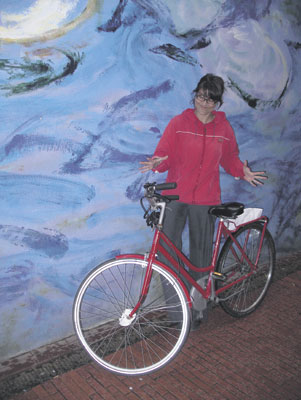The only problem is that she doesn’t know exactly where her bike is. As she says: “It’s not my fault! I just lent my bike to a friend for a couple of days, without thinking that something could go wrong.” But as that ‘friend’ later confessed rather jocosely: “Efi and I have known each other for a while, so she should’ve know that I’m a bit over-my-head when it comes to meaningless procedures like locking a bike.” With Efi’s borrowed bike stolen, the friend-in-question, in an ultimate act of redemption, ‘spontaneously’ offered to give Efi his bike in return for her loss. As Efi says: “He made me an offer I couldn’t refuse.” Days (or perhaps seconds later), Efi deeply regretted accepting this ‘generous’ offer. Her ‘new’ bike turned out to be “just some spare metal parts abstractly welded together with eyes closed”, she says laughing, some kind of vintage artifact carrying no brand or further identity, its past well-concealed under a thick rough layer of red paint. “The worrying thing is that it’s not safe at all, as it only has one semi-functioning brake”, Efi says, adding that she doesn’t much care that it also has no light, a jiggly stirring wheel and a chain that’s ‘just rust’, but having no brakes is making her re-think ’the concept of walking’. As for her bike’s price value, she estimates something between ‘zero and nothing’. With friends like these, who needs enemies?
<![CDATA[
]]>
Name: Thomas Andritsch
Nationality: Austrian
PhD supervisor:
Professor Johan Smit (high voltage components & power systems, faculty of
Electrical Engineering, Mathematics and Computer Science)
Subject: Evaluation of
nanodielectrics for high voltage DC applications
Thesis defense: A bit
more than a year to go
<![CDATA[
]]>
“Nanodielectrics form a fairly new research area in high voltage engineering. When I started
working on that topic at the University
of Graz, everybody was
surprised. Since we deal with such huge structures in high voltage engineering,
people wondered if it really made sense to work on nanoparticles to ameliorate
certain properties.
Scientists at TU Delft
are more accustomed to the idea. Together with some colleagues, I try to make
better insulation materials by adding nanoparticles to materials. I experiment
mostly with plastic insulation. These plastics – in my case epoxy – might end
up in x-ray machines in hospitals. X-ray machines work with very high voltages
and need good insulation. The lighter the insulation material is, the better,
since the scanner has to maneuver around the patient very quickly. The lighter
the structure, the faster it can turn and the better the x-ray pictures will
be.
By adding nano
particles, like aluminum oxide or magnesium oxide, to plastics, we can improve
the insulation in various ways. I’m figuring out the best way to do this. It’s
very complicated, since nanoparticles tend to stick together due to interatomic
forces. The last thing you want is groups of nanoparticles stuck together, because
those agglomerations might ‘suck up’ electrons, causing the insulation to break
down.
Manufacturers add
special coatings to prevent this, but, unfortunately, they keep secret what
chemicals they use. But in nanodielectronics we must know all the various
chemicals, in order to understand the insulation properties. A few years ago we
therefore took a tough decision, deciding to treat the particles and mix them
with the epoxy ourselves. For me this was something completely new.
To do this, we worked
together with researchers at DelftChemtech. That’s one of the things I like
about TU Delft: it’s easy to collaborate with other departments. Plus, it’s as
if I have a real job. I have my own desk and I’m paid a salary. In Austria, if
you’re conducting fundamental research as well as practical research, like I’m
doing, you’re stuck in the middle and you don’t receive any funding.
What I also like about
TU Delft is that I get to work with special equipment that is manufactured by
the university’s high voltage lab. In Graz
that wasn’t possible. Take for instance this instrument, which sends pulses of
high voltage through samples in order to determine where the nanoparticles are
agglomerated. If a pulse hits what is known as a ‘space charge’, an acoustic
wave is created that is captured by an acoustic sensor.
The tricky thing I
have to do now is to find out if certain characteristics of the material are
caused by the types of nanoparticles we use, the size of the particles or the
surface treatment.” (TvD)
<![CDATA[
]]>



Comments are closed.